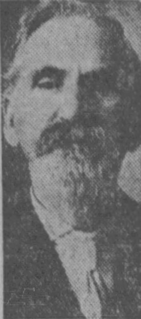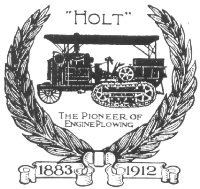
Waynesboro is a borough in Franklin County, Pennsylvania, on the southern border of the state. Waynesboro is in the Cumberland Valley between Hagerstown, Maryland, and Chambersburg, Pennsylvania. It is part of Chambersburg, PA Micropolitan Statistical Area, which is part of the Baltimore–Washington metropolitan area. It is 2 miles north of the Mason–Dixon line and close to Camp David and the Raven Rock Mountain Complex.

Studebaker was an American wagon and automobile manufacturer based in South Bend, Indiana. Founded in 1852 and incorporated in 1868 as the Studebaker Brothers Manufacturing Company, the firm was originally a coachbuilder, manufacturing wagons, buggies, carriages and harnesses.

A diesel locomotive is a type of railway locomotive in which the prime mover is a diesel engine. Several types of diesel locomotives have been developed, differing mainly in the means by which mechanical power is conveyed to the driving wheels.

The Baldwin Locomotive Works (BLW) was an American manufacturer of railroad locomotives from 1825 to 1956. Originally located in Philadelphia, it moved to nearby Eddystone, Pennsylvania, in the early 20th century. The company was for decades the world's largest producer of steam locomotives, but struggled to compete as demand switched to diesel locomotives. Baldwin produced the last of its 70,000-plus locomotives in 1956 and went out of business in 1972.

The English Electric Company Limited (EE) was a British industrial manufacturer formed after the armistice of World War I by amalgamating five businesses which, during the war, had been making munitions, armaments and aeroplanes.

A stationary engine is an engine whose framework does not move. They are used to drive immobile equipment, such as pumps, generators, mills or factory machinery, or cable cars. The term usually refers to large immobile reciprocating engines, principally stationary steam engines and, to some extent, stationary internal combustion engines. Other large immobile power sources, such as steam turbines, gas turbines, and large electric motors, are categorized separately.

The Hunslet Engine Company was founded in 1864 in Hunslet, Leeds, England. The company manufactured steam-powered shunting locomotives for over 100 years, and currently manufactures diesel-engined shunting locomotives. It is owned by Ed Murray & Sons.

Richmond Power Station was a coal fired power station which operated on the banks of the Yarra River in Richmond, Victoria, Australia from its construction in 1891 until its closure in 1976. It was one of the first alternating current (AC) electricity generation plants in the state. It has since been converted into office space and is the headquarters of international fashion brand Country Road and advertising agency CHE Proximity. The area in which it is located is now called Cremorne.

The Case Corporation was a manufacturer of construction equipment and agricultural equipment. Founded, in 1842, by Jerome Increase Case as the J. I. Case Threshing Machine Company, it operated under that name for most of a century. For another 66 years it was the J. I. Case Company, and was often called simply Case. In the late 19th century, Case was one of America's largest builders of steam engines, producing self-propelled portable engines, traction engines and steam tractors. It was a major producer of threshing machines and other harvesting equipment. The company also produced various machinery for the U.S. military. In the 20th century, Case was among the ten largest builders of farm tractors for many years. In the 1950s its construction equipment line became its primary focus, with agricultural business second.

The Advance-Rumely Company of La Porte, Indiana started in 1853 manufacturing threshers and later moved on to steam engines. It was an American pioneering producer of many types of agricultural machinery, most notably threshing machines and large tractors. Allis-Chalmers Manufacturing Co. purchased Advance-Rumley in 1931. The company's main works would become what was later known as the "La Porte plant".

The Avery Company, founded by Robert Hanneman Avery, was an American farm tractor manufacturer famed for its undermounted engine which resembled a railroad engine more than a conventional farm steam engine. Avery founded the farm implement business after the Civil War. His company built a large line of products, including steam engines, beginning in 1891. The company started with a return flue design and later adapted the undermount style, including a bulldog design on the smokebox door. Their design was well received by farmers in central Illinois. They expanded their market nationwide and overseas until the 1920s, when they failed to innovate and the company faltered. They manufactured trucks for a period of time, and then automobiles. until they finally succumbed to an agricultural crisis and the Depression.

Daniel Best was an American adventurer, inventor, and entrepreneur known for pioneering agriculture machinery and heavy machinery.

Reeves & Co. was an American farm tractor builder for thirty years, based in Columbus, Indiana. It built some of the largest steam traction engines used in North America.

Straker-Squire was a British automobile manufacturer based in Bristol, and later Edmonton in North London.

The Holt Manufacturing Company began with the 1883 founding of Stockton Wheel Service in Stockton, California, United States. Benjamin Holt, later credited with patenting the first workable crawler ("caterpillar") tractor design, incorporated the Holt Manufacturing Company in 1892. Holt Manufacturing Company was the first company to successfully manufacture a continuous track tractor By the early 20th century, Holt Manufacturing Company was the leading manufacturer of combine harvesters in the US, and the leading California-based manufacturer of steam traction engines.

Hesston Steam Museum is an outdoor museum operated by the Laporte County Historical Steam Society in Hesston, Indiana. The museum occupies 155 acres and is the home of four different gauge railroads along with numerous other pieces of steam powered and vintage farm equipment.

General Electric Specialty Control Plant is a 115 acres (47 ha) historic factory complex located at Waynesboro, Virginia. The complex includes three contributing buildings, one contributing site, and two contributing structures. The historic buildings and structures are a 340,000-square-foot main plant building, the original water tower, water tank, a group of evolved and interconnected construction sheds built from 1953 to the present, and an airplane hangar. The property, a former airport, was acquired by General Electric in 1953. The Waynesboro plant was one of some 120 individual operating departments created as part of a decentralization effort by the General Electric Corporation. The Specialty Control Plant was responsible for the development of breakthrough technologies in areas ranging from America's military efforts to space travel to computer technology. The facility was sold to GENICOM on October 21, 1983.

The John Fowler 7nhp Steam Road Locomotive is a heritage-listed former steam road locomotive with nominal power of 5.2 kilowatts (7 hp) and now exhibit at 9 Amaroo Drive, Wellington, in the Dubbo Regional Council local government area of New South Wales, Australia. It was designed and built by John Fowler & Co. (Leeds) Ltd in 1912. The property is owned by the Dubbo Regional Council and it was added to the New South Wales State Heritage Register on 18 November 2011.

Russell & Company of Massillon, Ohio, are best known for manufacturing farm and railroad machinery in the late 19th and early 20th centuries. Most notably 18,000 Steam tractors and Stationary engines, plus 22,000 Threshing machines.























